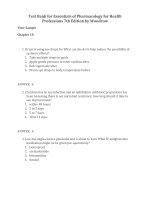Ebook Essentials of pharmacology for anesthesia, pain medicine and critical care: Part 1
Bạn đang xem bản rút gọn của tài liệu. Xem và tải ngay bản đầy đủ của tài liệu tại đây (2.15 MB, 372 trang )
Essentials of Pharmacology
for Anesthesia, Pain
Medicine, and Critical Care
Alan David Kaye
Adam M. Kaye
Richard D. Urman
Editors
123
Essentials of Pharmacology for Anesthesia,
Pain Medicine, and Critical Care
Alan David Kaye • Adam M. Kaye
Richard D. Urman
Editors
Essentials of Pharmacology
for Anesthesia, Pain Medicine,
and Critical Care
Editors
Alan David Kaye, MD, PhD
Departments of Anesthesiology
and Pharmacology
LSU Health Sciences Center
New Orleans, LA
USA
LSU Interim Hospital
and Ochsner Kenner Hospital
New Orleans, LA
USA
Adam M. Kaye, PharmD
Department of Pharmacy Practice
Thomas J. Long School of Pharmacy
and Health Sciences
University of the Pacific
Stockton, CA
USA
Richard D. Urman, MD, MBA
Department of Anesthesiology
Perioperative and Pain Medicine
Brigham and Women’s Hospital
Harvard Medical School
Boston, MA
USA
Ambulatory Care Center
Brigham and Women’s Hospital
Chestnut Hill, MA
USA
Center for Perioperative Management
and Medical Informatics
Department of Anesthesiology
Perioperative and Pain Medicine
Brigham and Women’s Hospital
Boston, MA
USA
ISBN 978-1-4614-8947-4
ISBN 978-1-4614-8948-1
DOI 10.1007/978-1-4614-8948-1
Springer New York Heidelberg Dordrecht London
(eBook)
Library of Congress Control Number: 2014948072
© Springer Science+Business Media New York 2015
This work is subject to copyright. All rights are reserved by the Publisher, whether the whole or part of
the material is concerned, specifically the rights of translation, reprinting, reuse of illustrations, recitation,
broadcasting, reproduction on microfilms or in any other physical way, and transmission or information
storage and retrieval, electronic adaptation, computer software, or by similar or dissimilar methodology
now known or hereafter developed. Exempted from this legal reservation are brief excerpts in connection
with reviews or scholarly analysis or material supplied specifically for the purpose of being entered and
executed on a computer system, for exclusive use by the purchaser of the work. Duplication of this
publication or parts thereof is permitted only under the provisions of the Copyright Law of the Publisher's
location, in its current version, and permission for use must always be obtained from Springer.
Permissions for use may be obtained through RightsLink at the Copyright Clearance Center. Violations
are liable to prosecution under the respective Copyright Law.
The use of general descriptive names, registered names, trademarks, service marks, etc. in this publication
does not imply, even in the absence of a specific statement, that such names are exempt from the relevant
protective laws and regulations and therefore free for general use.
While the advice and information in this book are believed to be true and accurate at the date of
publication, neither the authors nor the editors nor the publisher can accept any legal responsibility for
any errors or omissions that may be made. The publisher makes no warranty, express or implied, with
respect to the material contained herein.
Printed on acid-free paper
Springer is part of Springer Science+Business Media (www.springer.com)
Adam and I wish to thank our parents,
Florence Feldman and Joel Kaye, for their
love and support. We also want to thank our
stepparents, Andrea Kaye and the late
Gideon Feldman, along with the Gittelman
family for always helping and treating us
with love and kindness over our lifetime.
All three of us wish to thank Dr. Jonathan
Jahr and Dr. Karina Gritsenko, MD, for their
extra help in the preparation of this book.
This book has been the largest project I have
undertaken in many decades. I wish to
dedicate this book to everyone interested to
learn about anesthesia and pharmacology.
I also wish to dedicate this book to my
family: my wife Dr. Kim Kaye, my son Aaron,
and my daughter Rachel. I also wish to thank
my pharmacology and anesthesia mentors,
Dr. Alan W. Grogono, MD; Dr. Philip
J. Kadowitz, PhD; and Dr. Bobby
D. Nossaman, MD, for allowing me to
complete my PhD in pharmacology while
serving my full-time duties at Tulane Medical
Center many years ago.
Alan D. Kaye, MD, PhD
I would like to dedicate this book to my wife
Beth Kaye and daughter Jessica Kaye and
thank them from the bottom of my heart for
their patience and love. I would like to thank
James W. Blankenship, PhD, Emeritus
Professor, Department of Physiology and
Pharmacology, for stimulating my interest
while a student at the Thomas J. Long School
of Pharmacy and Health Sciences, University
of the Pacific. Most importantly, I would like
to thank my older and wiser brother Alan
Kaye for being my first teacher and best
friend.
Adam M. Kaye, PharmD
This book covers extensive amount of
material highly relevant to the practice of
anesthesiology, pain, and critical care
medicine. I would like to thank my
colleagues, students, and mentors for
encouraging me to undertake this massive
project. I hope that current and future
generations of practitioners and trainees will
benefit from my efforts. I would like to thank
my wife Zina Matlyuk, MD, for her editorial
assistance and advice. I wish to dedicate this
book to Zina, my daughters Abigail and
Isabelle, and my parents Dennis and Tanya
Urman.
Richard D. Urman, MD, MBA
Foreword
The word pharmacology is derived from the Greek φάρμακον, pharmakon,
and -λογία, -logia, “study of.” Strangely φάρμακον meant “poison” in classic Greek
but came to mean “drug” in the modern language. But what is a drug? It can be
described as anything manufactured, natural, or endogenous that exerts some physiological cellular. Pharmacology is the study of the interactions between a living
organism and substances that have an impact on normal or abnormal function.
The division between food and herbs is somewhat blurred as the latter preparations are not governed by the Food and Drug Administration but rather held to the
standards of the food industry where trials of effectiveness and universal testing of
safety are not required. However, the word “drug” is believed to originate from an
old French word “drogue” and later from the Dutch “droge-vate,” which referred to
the drying or preserving barrels used to store plants for medicinal use (in other
words, drugs and herbs are the same thing). Indeed, today about 30 % of our medicines derive directly from herbs, the only difference being that drugs have specified
amounts of active ingredients and herbs are not regulated as to content.
Some of our earliest medical texts have centered on medicinal therapies. The
Yellow Emperor’s Classic of Internal Medicine, collected around 2600 BC, describes
plants and foods that are applicable to the maintenance of health and the treatment
of specifically diseased organs. Writing in the first century AD, Pedanius Dioscorides
(circa 40–90 AD), a Greek physician, pharmacologist, and botanist, authored a
5-volume encyclopedia about some 600 herbal medicines that was the standard reference for 1,500 years. During the Renaissance the book was read in Latin, Greek,
and Arabic. Before that, in the seventh century AD, Paulus Aeginata, also Greek, in
a monumental act of plagiarism (although he does give some acknowledgements),
collected all the works of Hippocrates, Galen, Dioscorides, and Aretaeus, among
others, and produced seven books, the last of which is over 600 pages long and is
devoted entirely to herbal remedies. In all of these works, many of the drugs we use
today such as opium, aspirin, cannabis, castor oil, mandragora (atropine, scopolamine), cocaine, physostigmine, and digitalis among many others are listed. It is to
the efforts of William Withering to understand the effects of this last herb, digitalis,
from the purple foxglove, that we see the foundations of pharmacology. In his text,
vii
viii
Foreword
An Account of the Foxglove, Withering relates how he achieved the potion from an
old lady in Shropshire and sent samples to his colleagues to gauge under which
circumstances the extract would relieve lower extremity edema and other signs of
heart failure.
One of the frightening experiences the new resident in anesthesia has is encountering the sometimes bewildering array of medications that can take patients to the
door of death and then (hopefully) bring them back. With an aging population come
more comorbidities and the risk of drug interactions increases. Ever-increasing
complexity of machines, requirements for monitoring, and mandated data collection all add to the stress of the perioperative period. The ability to turn to a concise
yet easy to read comprehensive text on the drugs we use daily is something to be
treasured and an immense help for the practitioner. In this, the latest of a long line
of pharmaceutical texts, Drs. Kaye and Urman are to be congratulated on gathering
together such a wide range of authors from many different venues and perspectives.
The coverage of topics within Essentials of Pharmacology is indeed encyclopedic.
It is my hope that this book will allow practitioners of anesthesia to embrace the
topic of pharmacology and thus gain confidence in the knowledge that their patients
will be cared for appropriately and safely.
New York, NY, USA
Elizabeth A.M. Frost, MD
Preface
In many academic papers that we have read and written over the years, drugs are
described in abstract and theoretical ways. These drugs might possess novel mechanisms or improved duration of activity. These agents might be less toxic or possess
reduced side effects. Clearly, drugs dramatically affect our life spans, including our
quality of life. As the years have gone by, we have a much greater appreciation for
their wonders.
It was not long ago that our life spans were much shorter. Tens of thousands of
people died due to plague, an organism easily treated with sulfonamides. It is an
astonishing fact that dysentery was the single greatest cause of death of Confederate
and Union soldiers during our epic Civil War. Some of our greatest figures in history
had shortened lives related to what we would now consider very treatable states.
George Washington probably died of acute bacterial epiglottis. The poet Lord Byron
died prematurely from an epileptic seizure. Harry Houdini probably died from acute
appendicitis. Arthur Ashe died, in part, from transmission of the human immune
deficiency virus. Thousands of people die each year from NSAID-mediated silent
gastrointestinal bleeding.
Principally during the last 50 years, we have dramatically increased our understanding of disease states, and the technology to detect these states has also grown
significantly. Drug development has resulted in an increasing longevity, reduced
pain, and enhanced quality of life. On a daily basis in every community, an anesthesiologist is called to a code with a patient appearing lifeless and without hope and
delivers atropine, epinephrine, sodium bicarbonate, and calcium, and the patient is
ultimately rescued and stabilized. These drug-mediated miracles are commonplace
and routine in our practices.
In the last decade, we have seen complete cataloging of the entire human genome
and an increase in drug targets from five hundred to well over one thousand. No
longer is it a guaranteed death sentence to have human immune deficiency virus,
many types of cancers, or sepsis. There is now new hope in drug targeting for vascular atherosclerosis, diabetes mellitus, cardiomyopathy, many cancers, and even
Alzheimer’s disease. We find ourselves constantly at a new beginning with
drugs, including in our fields of anesthesia and pain medicine. Structural activity
ix
x
Preface
relationships and complex three-dimensional analyses of therapeutic targets have
produced further advances. Freudenberg received a patent for a cyclodextrin structure in 1953; while, in 2014, we appreciate the role of a cyclodextrin-structured
agent, sugammadex, in neuromuscular drug reversal. Forty years ago, we first identified an opiate receptor. In recent years, we have made substantial increases in
understanding of endogenous opiates and subgroup opioid receptors throughout the
body. With these understandings, our future will ultimately see better targeting
agents for acute and chronic pain states. It is an exciting time filled with hope in
modern medicine and in our field. Anesthesia has never been safer, thanks, in part,
to drug development.
In this book, we have attempted to cover all pharmacological considerations in
the field of anesthesiology in a slightly different way. The first section of the book
covers basic drugs, including an introduction, mechanisms, drug class, structure,
drug interactions, side effects, black box warnings, and clinical pearls. The second
section looks at pharmacological considerations in each anesthesia-related subspecialty. The third section is timely and describes interesting and provocative current
topics that directly influence how we practice anesthesiology. The final section is
devoted to new vistas in many aspects of both anesthesiology and pain
management.
History affords us lessons and clues to be better prepared for our present and
futures. We must remain critical about expectations regarding quality and standardization of our drugs in order to maintain appropriate bioavailability and therapeutic
outcomes. An appreciation of current black box warnings in the United States is
given a special focus in this book. We must be leaders as many people within our
hospitals suddenly are finding it their business to influence our practices and decision making. It is a golden age for drugs, and we should continue to improve the
quality of life on this planet. Let us all be up to the challenge one patient at a time.
New Orleans, LA, USA Alan David Kaye, MD, PhD, DABA, DABPM, DABIPP
Stockton, CA, USA
Adam M. Kaye, PharmD, FASCP, FCPhA
Boston, MA, USA
Richard D. Urman, MD, MBA, CPE
Contents
Part I
Basic Pharmacologic Principles
1
Pharmacokinetics and Pharmacodynamics of Anesthetics . . . . . . . .
Patrick Chan and James A. Uchizono
3
2
A Review of Mechanisms of Inhalational Anesthetic Agents. . . . . . .
Elizabeth A.M. Frost
49
3
Pharmacokinetics, Pharmacodynamics, and Physical Properties
of Inhalational Agents . . . . . . . . . . . . . . . . . . . . . . . . . . . . . . . . . . . . . .
Hanjo Ko, Alan David Kaye, and Richard D. Urman
61
4
Principles of Total Intravenous Anesthesia . . . . . . . . . . . . . . . . . . . . .
Basavana Gouda Goudra and Preet Mohinder Singh
73
5
Perioperative Considerations in Pharmacology . . . . . . . . . . . . . . . . .
Angela Vick, Amaresh Vydyanathan, Tarang Safi,
and Karina Gritsenko
87
Part II
Drug Classes
6
Anesthetic Induction Agents . . . . . . . . . . . . . . . . . . . . . . . . . . . . . . . . .
David Hirsch, Charles Fox, and Alan David Kaye
7
Analgesics: Opiate Agonists, Mixed Agonists/Antagonists,
and Antagonists for Acute Pain Management. . . . . . . . . . . . . . . . . . .
Orlando J. Salinas and Christopher K. Merritt
113
Analgesics: Opioids for Chronic Pain Management
and Surgical Considerations . . . . . . . . . . . . . . . . . . . . . . . . . . . . . . . . .
Roy Esaki and Alex Macario
125
8
9
Nonopioid Analgesic and Adjunct Drugs . . . . . . . . . . . . . . . . . . . . . .
Mary Bekhit, Kaveh Navab, Andrew Ghobrial, and Tod Aust
103
147
xi
xii
Contents
10
Benzodiazepines and Muscle Relaxants. . . . . . . . . . . . . . . . . . . . . . . .
Joyce C. Lo and Alan David Kaye
167
11
Pharmacology of Local Anesthetics . . . . . . . . . . . . . . . . . . . . . . . . . . .
Neesa Patel and Alireza Sadoughi
179
12
Neuromuscular Blockers . . . . . . . . . . . . . . . . . . . . . . . . . . . . . . . . . . . .
Gabriel Goodwin and Vilma Joseph
195
13
Reversal Agents . . . . . . . . . . . . . . . . . . . . . . . . . . . . . . . . . . . . . . . . . . .
Andrew Sim and Angela Vick
205
14
Drugs Acting on the Autonomic Nervous System . . . . . . . . . . . . . . . .
John Pawlowski
219
15
Antihypertensives, Diuretics, and Antidysrhythmics . . . . . . . . . . . . .
Ryan Field
235
16
Peripheral Vasodilators . . . . . . . . . . . . . . . . . . . . . . . . . . . . . . . . . . . . .
Ratan K. Banik and Jay S. Berger
257
17
Nitric Oxide and Pulmonary Vasodilators. . . . . . . . . . . . . . . . . . . . . .
Michelle Schlunt
275
18
Asthma and COPD Agents . . . . . . . . . . . . . . . . . . . . . . . . . . . . . . . . . .
Alexis Appelstein and Mabel Chung
295
19
Hormones, Part 1: Thyroid and Corticosteroid Hormones . . . . . . . .
Joe C. Hong
313
20
Hormones Part 2: Insulin and Other Glucose-Controlling
Medications. . . . . . . . . . . . . . . . . . . . . . . . . . . . . . . . . . . . . . . . . . . . . . .
Kumar Vivek, Shamantha Reddy, and Justo Gonzalez
327
Antacids, Gastrointestinal Prokinetics,
and Proton Pump Inhibitors . . . . . . . . . . . . . . . . . . . . . . . . . . . . . . . . .
Sunitha Kanchi Kandadai and Mark V. Boswell
345
21
22
Histamine Modulators . . . . . . . . . . . . . . . . . . . . . . . . . . . . . . . . . . . . . .
Michael Yarborough and Judy G. Johnson
365
23
Central Nervous System Stimulants. . . . . . . . . . . . . . . . . . . . . . . . . . .
Eric S. Hsu
381
24
Anticoagulant Drugs . . . . . . . . . . . . . . . . . . . . . . . . . . . . . . . . . . . . . . .
Subarna Biswas, Jun Sasaki, and Michelle Braunfeld
397
25
Hemostatic Agents . . . . . . . . . . . . . . . . . . . . . . . . . . . . . . . . . . . . . . . . .
John S. McNeil and M. Dustin Boone
415
26
Blood, Blood Products, and Substitutes. . . . . . . . . . . . . . . . . . . . . . . .
Molly Chung, Laura Mayer, Hamid Nourmand, Michelle You,
and Jonathan S. Jahr
421
Contents
27
xiii
Antipyretics: Acetaminophen, Arachidonic Acid Agents,
and COX1 and COX2 Inhibitors . . . . . . . . . . . . . . . . . . . . . . . . . . . . .
My Tu, Karina Gritsenko, Boleslav Kosharskyy,
and Naum Shaparin
433
28
Antiemetic Agents . . . . . . . . . . . . . . . . . . . . . . . . . . . . . . . . . . . . . . . . .
Aaron M. Fields
445
29
Antiepileptic Agents. . . . . . . . . . . . . . . . . . . . . . . . . . . . . . . . . . . . . . . .
Angelika Kosse and Heesung Kang
453
30
Neuropharmacologic Agents for Neurologic Conditions . . . . . . . . . .
Maria Bustillo and Tricia Vecchione
485
31
Chemotherapeutic Agents . . . . . . . . . . . . . . . . . . . . . . . . . . . . . . . . . . .
Adrienne B. Warrick, Karina Gritsenko, and Melinda Aquino
503
32
Antimicrobial Agents. . . . . . . . . . . . . . . . . . . . . . . . . . . . . . . . . . . . . . .
Rebecca Johnson, Richard Lancaster, and Timothy Ku
525
33
Herbal Medications and Vitamin Supplements . . . . . . . . . . . . . . . . .
Philip Gregory, Andrew Abe, and Darren Hein
549
34
Minerals and Electrolytes . . . . . . . . . . . . . . . . . . . . . . . . . . . . . . . . . . .
Amit Prabhakar, Alan David Kaye, and Amir Baluch
563
35
Disinfection Agents and Antiseptics . . . . . . . . . . . . . . . . . . . . . . . . . . .
Valeriy Kozmenko, Rudolph R. Gonzales Jr., James Riopelle,
and Alan David Kaye
573
36
Psychopharmacologic Agents and Psychiatric
Drug Considerations . . . . . . . . . . . . . . . . . . . . . . . . . . . . . . . . . . . . . . .
Charles Fox, Alan David Kaye, and Henry Liu
37
Cocaine, Methamphetamine, MDMA, and Heroin. . . . . . . . . . . . . . .
Ethan O. Bryson
Part III
581
595
Clinical Subspecialties
38
Cardiac Surgery . . . . . . . . . . . . . . . . . . . . . . . . . . . . . . . . . . . . . . . . . . .
Henry Liu, Hong Yan, Ming Chen, Mingbing Chen, Charles Fox,
and Alan David Kaye
609
39
The Intensive Care Unit . . . . . . . . . . . . . . . . . . . . . . . . . . . . . . . . . . . .
Brian O’Gara and Shahzad Shaefi
645
40
Enteral and Parenteral Nutrition . . . . . . . . . . . . . . . . . . . . . . . . . . . . .
Jillian Redgate and Sumit Singh
661
41
Obstetrics . . . . . . . . . . . . . . . . . . . . . . . . . . . . . . . . . . . . . . . . . . . . . . . .
Laura Mayer, Richard Hong, and Jeff Bernstein
677
xiv
Contents
42
Pediatrics. . . . . . . . . . . . . . . . . . . . . . . . . . . . . . . . . . . . . . . . . . . . . . . . .
Vanessa Ng, Karina Gritsenko, and Rebecca Lintner
697
43
Neurologic Surgery . . . . . . . . . . . . . . . . . . . . . . . . . . . . . . . . . . . . . . . .
Allison Spinelli and Robyn Landy
707
44
Liver Disease and Liver Transplantation . . . . . . . . . . . . . . . . . . . . . .
Gundappa Neelakanta and Victor Xia
719
Part IV
Special Topics
45
Black Box FDA Warnings and Legal Implications . . . . . . . . . . . . . . .
Meghan Lane-Fall
741
46
Drug-Induced QT Prolongation . . . . . . . . . . . . . . . . . . . . . . . . . . . . . .
Elizabeth A. Valentine, Alan David Kaye, Jackie V. Abadie,
and Adam M. Kaye
753
47
Drugs and Cancer Propagation . . . . . . . . . . . . . . . . . . . . . . . . . . . . . .
Amit Prabhakar, Alan David Kaye, and Richard D. Urman
767
48
Lipid-Lowering Agents . . . . . . . . . . . . . . . . . . . . . . . . . . . . . . . . . . . . .
Scott D. Friedman and Brian McClure
783
49
Serotonin Syndrome . . . . . . . . . . . . . . . . . . . . . . . . . . . . . . . . . . . . . . .
Julie A. Gayle, Jacqueline Volpi Abadie, Adam M. Kaye,
and Alan David Kaye
797
Part V
50
New Vistas in Pharmacology
Novel Psychoactive Substances: Synthetic Cathinones
and Cannabinoid Receptor Agonists . . . . . . . . . . . . . . . . . . . . . . . . . .
Ethan O. Bryson
811
51
New Vistas in Anesthetics, IV Induction Agents. . . . . . . . . . . . . . . . .
John Pawlowski
819
52
New Vistas in Neuromuscular Blockers. . . . . . . . . . . . . . . . . . . . . . . .
Matthew T. Murrell and John J. Savarese
827
53
Patient-Controlled Analgesia: The Importance of Effector
Site Pharmacokinetics . . . . . . . . . . . . . . . . . . . . . . . . . . . . . . . . . . . . . .
Pamela P. Palmer and Mike A. Royal
837
54
Understanding Anesthesia-Induced Memory Loss. . . . . . . . . . . . . . .
Agnieszka A. Zurek and Beverley A. Orser
847
55
Novel Targets of Current Analgesic Drug Development . . . . . . . . . .
Jeffrey A. Katz and Honorio T. Benzon
859
Index . . . . . . . . . . . . . . . . . . . . . . . . . . . . . . . . . . . . . . . . . . . . . . . . . . . . . . . .
875
Contributors
Jacqueline Volpi Abadie, MD Department of Anesthesiology, Alton Ochsner
Clinic, New Orleans, LA, USA
Andrew Abe, PharmD Drug Information Center, University of Kansas,
Lawrence, KS, USA
Alexis Appelstein, DO Department of Anesthesiology,
Montefiore Medical Center, Albert Einstein College of Medicine,
Bronx, NY, USA
Melinda Aquino, MD Department of Anesthesiology,
Montefiore Medical Center, Albert Einstein College of Medicine – Yeshiva
University, Bronx, NY, USA
Tod Aust, MD Department of Anesthesiology, David Geffen School
of Medicine at UCLA, Los Angeles, CA, USA
Amir Baluch, MD Metropolitan Anesthesia Consultants, Dallas, TX, USA
Ratan K. Banik, MD, PhD Department of Anesthesiology,
Montefiore Medical Center, Albert Einstein College of Medicine,
Bronx, NY, USA
Mary Bekhit, MD Department of Anesthesiology, Ronald Reagan UCLA
Medical Center, Los Angeles, CA, USA
Honorio T. Benzon, MD Department of Anesthesiology,
Northwestern University Feinberg School of Medicine, Chicago, IL, USA
Jay S. Berger, MD, PhD Department of Anesthesiology,
Montefiore Medical Center, Albert Einstein College of Medicine,
Bronx, NY, USA
Jeff Bernstein Department of Anesthesiology, Montefiore Medical Center,
Albert Einstein College of Medicine, Bronx, NY, USA
xv
xvi
Contributors
Subarna Biswas, MD Department of Surgery, UCLA Medical Center,
Los Angeles, CA, USA
M. Dustin Boone, MD Department of Anesthesia, Harvard Medical School,
Boston, MA, USA
Department of Anesthesia, Critical Care and Pain Medicine,
Beth Israel Deaconess Medical Center, Boston, MA, USA
Mark V. Boswell, MD, PhD, MBA Department of Anesthesiology
and Perioperative Medicine, University of Louisville School of Medicine,
Louisville, KY, USA
Michelle Braunfeld UCLA Department of Anesthesiology,
David Geffen School of Medicine at UCLA, Los Angeles, CA, USA
Ethan O. Bryson, MD Departments of Anesthesiology and Psychiatry,
The Mount Sinai School of Medicine, New York, NY, USA
Maria Bustillo, MD Department of Anesthesiology, Montefiore Medical Center,
Albert Einstein College of Medicine, Bronx, NY, USA
Patrick Chan, PharmD, PhD Department of Pharmacy Practice and
Administration, Western University of Health Sciences, Pomona, CA, USA
Ming Chen, MD Department of Anesthesiology, Hubei Women and Children’s
Hospital, Wuhan, China
Mingbing Chen, MD Department of Anesthesiology, Tulane University Medical
Center, New Orleans, LA, USA
Mabel Chung, MD Department of Anesthesiology, Montefiore Medical Center,
Albert Einstein College of Medicine, Bronx, NY, USA
Molly Chung, MD Department of Anesthesiology, David Geffen School
of Medicine at UCLA, Ronald Reagan UCLA Medical Center,
Los Angeles, CA, USA
Roy Esaki, MD, MS Department of Anesthesiology, Perioperative
and Pain Medicine, Stanford University School of Medicine, Stanford,
CA, USA
Ryan Field, MD Department of Anesthesiology and Perioperative Care,
School of Medicine, University of California–Irvine, Irvine, CA, USA
Aaron M. Fields, MD Department of Anesthesiology, Tripler Army Medical
Center, Honolulu, HI, USA
Charles Fox, MD Department of Anesthesiology, LSU Health Science
Center Shreveport, Shreveport, LA, USA
Scott D. Friedman, MD Department of Anesthesiology, Tulane University
School of Medicine, New Orleans, LA, USA
Contributors
xvii
Elizabeth A.M. Frost, MD Department of Anesthesiology,
Icahn School of Medicine at Mount Sinai, New York, NY, USA
Julie A. Gayle, MD Department of Anesthesiology, Louisiana State University
Health Sciences Center, New Orleans, LA, USA
Andrew Ghobrial, MD Department of Anesthesiology, David Geffen School
of Medicine at UCLA, Los Angeles, CA, USA
Rudolph R. Gonzales Jr., RN, MSN, CNOR, CRCST, CHL Sterile Processing
Services, North Texas Veterans Administration Health Care System,
Dallas, TX, USA
Justo Gonzalez, MD Department of Anesthesiology, Montefiore Medical Center,
Albert Einstein College of Medicine, Bronx, NY, USA
Gabriel Goodwin Department of Anesthesiology, Montefiore Medical Center,
Albert Einstein College of Medicine, Bronx, NY, USA
Basavana Gouda Goudra, MD, FRCA, FCARCSI Department of Clinical
Anesthesiology and Critical Care, Perelman School of Medicine, Philadelphia,
PA, USA
Department of Anesthesiology and Critical Care Medicine,
Hospital of the University of Pennsylvania, Philadelphia, PA, USA
Philip Gregory, PharmD Center for Drug Information
and Evidence-Based Practice, Creighton University, Omaha, NE, USA
Karina Gritsenko, MD Department of Anesthesiology,
Montefiore Medical Center, Albert Einstein College of Medicine,
Yeshiva University, Bronx, NY, USA
Department of Family and Social Medicine, Montefiore Medical Center,
Albert Einstein College of Medicine, Yeshiva University, Bronx, NY, USA
Darren Hein, PharmD Center for Drug Information and Evidence-Based
Practice, Creighton University, Omaha, NE, USA
David Hirsch, MD Department of Anesthesiology, Tulane Medical Center,
New Orleans, LA, USA
Joe C. Hong, MD UCLA Department of Anesthesiology,
Ronald Reagan UCLA Medical Center, Los Angeles, CA, USA
Richard Hong Department of Anesthesiology,
Ronald Reagan UCLA Medical Center, Los Angeles, CA, USA
Eric Hsu, MD Anesthesiology Pain Medicine Center,
UCLA–School of Medicine, University of California, Los Angeles, USA
Jonathan S. Jahr, MD Department of Anesthesiology,
David Geffen School of Medicine at UCLA, Ronald Reagan UCLA Medical Center,
Los Angeles, CA, USA
xviii
Contributors
Judy Johnson, MD Department of Anesthesiology, Louisiana State University,
New Orleans, LA, USA
Rebecca Johnson, MD Department of Anesthesiology, Tulane Medical Center,
New Orleans, LA, USA
Vilma Joseph Department of Anesthesiology, Montefiore Medical Center,
Albert Einstein College of Medicine, Bronx, NY, USA
Sunitha Kanchi Kandadai, MD Department of Anesthesiology
and Perioperative Medicine, University of Louisville School of Medicine,
Louisville, KY, USA
Heesung Kang, MD Department of Anesthesiology, Montefiore Medical Center,
Albert Einstein College of Medicine of Yeshiva University, Bronx, NY, USA
Jeffrey A. Katz, MD Department of Anesthesiology,
Northwestern University Feinberg School of Medicine, Chicago, IL, USA
Adam M. Kaye, PharmD Thomas J. Long School of Pharmacy
and Health Sciences, University of the Pacific, Stockton, CA, USA
Alan David Kaye, MD, PhD Department of Anesthesiology,
Tulane Medical Center, New Orleans, LA, USA
Department of Anesthesiology, Louisiana State University Health Sciences Center,
New Orleans, LA, USA
Hanjo Ko, MD Department of Anesthesiology and Perioperative Medicine,
Brigham and Women’s Hospital, Boston, MA, USA
Boleslav Kosharskyy, MD Department of Anesthesiology,
Albert Einstein School of Medicine – Yeshiva University,
Montefiore Medical Center, Bronx, NY, USA
Angelika Kosse, MD Department of Anesthesiology, Montefiore Medical Center,
Albert Einstein College of Medicine of Yeshiva University, Bronx, NY, USA
Valeriy Kozmenko, MD Department of Anesthesiology,
Louisiana State University Health Sciences Center, New Orleans, LA, USA
Timothy Ku, MD Department of Anesthesiology, Tulane Medical Center,
New Orleans, LA, USA
Richard Lancaster, MD Department of Anesthesiology, Tulane Medical Center,
New Orleans, LA, USA
Robyn Landy, MD Department of Anesthesiology, Montefiore Medical Center,
Albert Einstein College of Medicine, Bronx, NY, USA
Meghan Brooks Lane-Fall, MD, MSHP Department of Anesthesiology and
Critical Care, University of Pennsylvania, Philadelphia, PA, USA
Contributors
xix
Rebecca Lintner, MD Department of Anesthesiology,
Montefiore Medical Center, Albert Einstein College of Medicine,
Bronx, NY, USA
Henry Liu, MD Department of Anesthesiology, Tulane Medical Center,
New Orleans, LA, USA
Joyce C. Lo, MD Department of Anesthesiology, Pain, and Perioperative Care,
Stanford University School of Medicine, Palo Alto, CA, USA
Alex Macario, MD, MBA Department of Anesthesiology, Perioperative and Pain
Medicine, Stanford University School of Medicine, Stanford, CA, USA
Laura Mayer, MD Department of Anesthesiology,
David Geffen School of Medicine at UCLA, Ronald Reagan UCLA Medical Center,
Los Angeles, CA, USA
Brian McClure Department of Anesthesiology,
Tulane University School of Medicine, New Orleans, LA, USA
John S. McNeil, MD Department of Anesthesia, Harvard Medical School,
Boston, MA, USA
Department of Anesthesia, Critical Care and Pain Medicine,
Beth Israel Deaconess Medical Center, Boston, MA, USA
Christopher K. Merritt, MD Department of Anesthesiology, Louisiana State
University, New Orleans, LA, USA
Matthew T. Murrell, MD, PhD Department of Anesthesiology,
Weill Cornell Medical College, New York, NY, USA
Kaveh Navab, MD Department of Anesthesiology,
David Geffen School of Medicine at UCLA, Los Angeles, CA, USA
Gundappa Neelakanta, MD Department of Anesthesiology,
Ronald Reagan UCLA Medical Center, David Geffen School of Medicine at UCLA,
Los Angeles, CA, USA
Vanessa Ng, MD Department of Anesthesiology, Montefiore Medical Center,
Albert Einstein College of Medicine, Bronx, NY, USA
Hamid Nourmand, MD Department of Anesthesiology,
David Geffen School of Medicine at UCLA, Ronald Reagan UCLA Medical Center,
Los Angeles, CA, USA
Brian O’Gara, MD Department of Anesthesia, Harvard Medical School,
Boston, MA, USA
Department of Anesthesia, Critical Care and Pain Medicine,
Beth Israel Deaconess Medical Center, Boston, MA, USA
xx
Contributors
Beverley A. Orser Department of Physiology, University of Toronto, Toronto,
ON, Canada
Department of Anesthesia, Sunnybrook Health Sciences Centre, Toronto,
ON, Canada
Department of Anesthesia, University of Toronto, Toronto, ON, Canada
Pamela P. Palmer, MD, PhD AcelRx Pharmaceuticals, Inc., Redwood City,
CA, USA
Neesa Patel, MD Department of Anesthesiology, UCLA - Santa Monica Medical
Center and Orthopedic Hospital, Santa Monica, CA, USA
Department of Anesthesiology, Ronald Reagan UCLA Medical Center,
Los Angeles, CA, USA
Department of Anesthesiology, David Geffen School of Medicine,
University of California, Los Angeles, CA, USA
John Pawlowski Division of Thoracic Anesthesia,
Beth Israel Deaconess Medical Center, Boston, MA, USA
Amit Prabhakar, MD, MS Department of Anesthesiology, Louisiana State
University Health Sciences Center, New Orleans, LA, USA
Shamantha Reddy, MD Department of Anesthesiology, Montefiore Medical
Center, Albert Einstein College of Medicine, Bronx, NY, USA
Jillian Redgate, RD, CNSC Nutrition and Food Services,
VA Greater Los Angeles Healthcare System, Los Angeles, CA, USA
James Riopelle, MD Department of Anesthesiology,
Louisiana State University Health Sciences Center, New Orleans, LA, USA
Mike A. Royal, MD, MBA, JD AcelRx Pharmaceuticals, Inc.,
Redwood City, CA, USA
Alireza Sadoughi, MD Department of Anesthesiology, UCLA - Santa Monica
Medical Center and Orthopedic Hospital, Santa Monica, CA, USA
Department of Anesthesiology, David Geffen School of Medicine,
University of California, Los Angeles, CA, USA
Tarang Safi, MD Department of Anesthesiology, Montefiore Medical Center,
Albert Einstein College of Medicine, Yeshiva University, Bronx, NY, USA
Orlando J. Salinas, MD Department of Anesthesiology,
Louisiana State University, New Orleans, LA, USA
Jun Sasaki, MD UCLA Department of Anesthesiology,
David Geffen School of Medicine at UCLA, Los Angeles, CA, USA
John J. Savarese, MD Department of Anesthesiology,
Weill Cornell Medical College, New York, NY, USA
Contributors
xxi
Michelle Schlunt, MD Department of Anesthesiology, Loma Linda University,
Loma Linda, CA, USA
Shahzad Shaefi, MD Department of Anesthesia, Harvard Medical School,
Boston, MA, USA
Department of Anesthesia, Critical Care and Pain Medicine,
Beth Israel Deaconess Medical Center, Boston, MA, USA
Naum Shaparin, MD Department of Anesthesiology,
Albert Einstein School of Medicine – Yeshiva University, Montefiore Medical Center,
Bronx, NY, USA
Department of Family and Social Medicine, Albert Einstein School
of Medicine – Yeshiva University, Montefiore Medical Center, Bronx, NY, USA
Andrew Sim, MD Department of Anesthesiology, Montefiore Medical Center,
Albert Einstein College of Medicine, Bronx, NY, USA
Preet Mohinder Singh, MD, DNB Department of Anesthesia,
All India Institute of Medical Sciences, New Delhi, India
Sumit Singh, MD, UCLA Department of Anesthesiology,
David Geffen School of Medicine at UCLA, Los Angeles, CA, USA
Nutrition and Food Services, VA Greater Los Angeles Healthcare System,
Los Angeles, CA, USA
Allison Spinelli, MD Department of Anesthesiology, Montefiore Medical Center,
Albert Einstein College of Medicine, Bronx, NY, USA
My Tu, MD Department of Anesthesiology, Albert Einstein School
of Medicine – Yeshiva University, Montefiore Medical Center, Bronx, NY, USA
James A. Uchizono, PharmD, Phd Department of Pharmaceutics and Medicinal
Chemistry, University of the Pacific, Stockton, CA, USA
Richard D. Urman, MD, MBA Department of Anesthesiology, Perioperative
and Pain Medicine, Brigham and Women’s Hospital, Harvard Medical School,
Boston, MA, USA
Center for Perioperative Management and Medical Informatics,
Brigham and Women’s Hospital, Boston, MA, USA
Elizabeth Valentine, MD Department of Anesthesiology and Critical Care,
Perelman School of Medicine at the University of Pennsylvania, Philadelphia,
PA, USA
Tricia Vecchione, MD Department of Anesthesiology,
Montefiore Medical Center, Albert Einstein College of Medicine,
Bronx, NY, USA
Angela Vick, MD Department of Anesthesiology, Montefiore Medical Center,
Albert Einstein College of Medicine, Yeshiva University, Bronx, NY, USA
xxii
Contributors
Kumar Vivek, MD Department of Anesthesiology, Montefiore Medical Center,
Albert Einstein College of Medicine, Bronx, NY, USA
Jackie V. Abadie, MD Department of Anesthesiology, Alton Ochsner Clinic,
New Orleans, LA, USA
Amaresh Vydyanathan, MD, MS Department of Anesthesiology,
Montefiore Medical Center, Albert Einstein College of Medicine,
Yeshiva University, Bronx, NY, USA
Adrienne B. Warrick, MD Department of Anesthesiology,
Montefiore Medical Center, Albert Einstein College of Medicine – Yeshiva
University, Bronx, NY, USA
Victor Xia, MD Department of Anesthesiology, Ronald Reagan UCLA
Medical Center, David Geffen School of Medicine at UCLA, Los Angeles,
CA, USA
Hong Yan Department of Anesthesiology, Wuhan Central Hospital,
Wuhan, China
Michael Yarborough, MD Department of Anesthesiology,
Tulane Medical Center, New Orleans, LA, USA
Michelle You Department of Anesthesiology, David Geffen School
of Medicine at UCLA, Ronald Reagan UCLA Medical Center,
Los Angeles, CA, USA
Agnieszka A. Zurek Department of Physiology, University of Toronto,
Toronto, ON, Canada
Part I
Basic Pharmacologic Principles
Chapter 1
Pharmacokinetics and Pharmacodynamics
of Anesthetics
Patrick Chan and James A. Uchizono
Contents
Introduction . . . . . . . . . . . . . . . . . . . . . . . . . . . . . . . . . . . . . . . . . . . . . . . . . . . . . . . . . . . . . .
Absorption . . . . . . . . . . . . . . . . . . . . . . . . . . . . . . . . . . . . . . . . . . . . . . . . . . . . . . . . . . . . . . .
Volume of Distribution. . . . . . . . . . . . . . . . . . . . . . . . . . . . . . . . . . . . . . . . . . . . . . . . . . . . . .
Clearance . . . . . . . . . . . . . . . . . . . . . . . . . . . . . . . . . . . . . . . . . . . . . . . . . . . . . . . . . . . . . . . .
Metabolism . . . . . . . . . . . . . . . . . . . . . . . . . . . . . . . . . . . . . . . . . . . . . . . . . . . . . . . . . . . .
Excretion. . . . . . . . . . . . . . . . . . . . . . . . . . . . . . . . . . . . . . . . . . . . . . . . . . . . . . . . . . . . . .
Elimination Rate Constant and Half-Life . . . . . . . . . . . . . . . . . . . . . . . . . . . . . . . . . . . . . . .
Pharmacodynamics . . . . . . . . . . . . . . . . . . . . . . . . . . . . . . . . . . . . . . . . . . . . . . . . . . . . . . . .
Therapeutic Range and Therapeutic Monitoring . . . . . . . . . . . . . . . . . . . . . . . . . . . . . . . . . .
Drug Tables . . . . . . . . . . . . . . . . . . . . . . . . . . . . . . . . . . . . . . . . . . . . . . . . . . . . . . . . . . . . . .
References . . . . . . . . . . . . . . . . . . . . . . . . . . . . . . . . . . . . . . . . . . . . . . . . . . . . . . . . . . . . . . .
3
5
6
7
8
8
9
10
11
12
43
Introduction
Our understanding of the numerous barriers and cascades that govern drug kinetic
and dynamic behavior of clinical response(s) continues to grow in complexity as the
inextricable link between pharmacokinetics (PK) and pharmacodynamics (PD)
becomes increasingly apparent. Colloquially, PK is described as “what the body
P. Chan, PharmD, PhD (*)
Department of Pharmacy Practice and Administration,
Western University of Health Sciences, Pomona, CA, USA
e-mail:
J.A. Uchizono, PharmD, PhD
Department of Pharmaceutics and Medicinal Chemistry,
University of the Pacific, Stockton, CA, USA
e-mail: juchizono@pacific.edu
A.D. Kaye et al. (eds.), Essentials of Pharmacology for Anesthesia,
Pain Medicine, and Critical Care, DOI 10.1007/978-1-4614-8948-1_1,
© Springer Science+Business Media New York 2015
3









